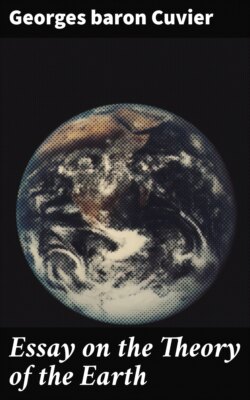Читать книгу Essay on the Theory of the Earth - Georges baron Cuvier - Страница 8
На сайте Литреса книга снята с продажи.
First proofs of Revolutions on the surface of the Globe.
ОглавлениеTable of Contents
The lowest and most level parts of the earth, exhibit nothing, even when penetrated to a very great depth, but horizontal strata composed of substances more or less varied, and containing almost all of them innumerable marine productions. Similar strata, with the same kind of productions, compose the lesser hills to a considerable height. Sometimes the shells are so numerous as to constitute of themselves the entire mass of the rock; they rise to elevations superior to the level of every part of the ocean, and are found in places where no sea could have carried them at the present day, under any circumstances; they are not only enveloped in loose sand, but are often inclosed in the hardest rocks. Every part of the earth, every hemisphere, every continent, every island of any extent, exhibits the same phenomenon.
The times are past when ignorance could maintain, that these remains of organized bodies are mere sportings of nature, productions generated in the womb of the Earth, by its own creative powers; and the efforts made by some metaphysicians of the present day, will not probably succeed in bringing these exploded opinions again into repute. A scrupulous comparison of the forms of these remains, of their texture, and often even of their chemical composition, does not disclose the slightest difference between the fossil shells and those which still inhabit the sea: the preservation of the former is not less perfect than that of the latter; most commonly we neither observe detrition nor fracture in them, nothing, in short, that announces a violent removal from their original places; the smallest of them retain their sharpest ridges, and their most delicate spines. They have, therefore, not only lived in the sea, but they have also been deposited by it. It is the sea which has left them in the places where they are now found. But this sea has remained for a certain period in those places; it has covered them long enough, and with sufficient tranquillity to form those deposits, so regular, so thick, so extensive, and partly also so solid, which contain those remains of aquatic animals. The basin of the sea has therefore undergone one change at least, either in extent, or in situation. Such is the result of the very first search, and of the most superficial examination.
The traces of revolutions become still more apparent and decisive, when we ascend a little higher, and approach nearer to the foot of the great chains. There are still found many beds of shells; some of these are even thicker and more solid; the shells are quite as numerous, and as well preserved, but they are no longer of the same species. The strata which contain them are not so generally horizontal; they assume an oblique position, and are sometimes almost vertical. While in the plains and low hills it was necessary to dig deep, in order to discover the succession of the beds, we here discover it at once by their exposed edges, as we follow the valleys that have been produced by their disjunction. Great masses of debris form at the foot of the cliffs, rounded hills, the height of which is augmented by every thaw and tempest.
These inclined strata, which form the ridges of the secondary mountains, do not rest upon the horizontal strata of the hills which are situate at their base, and which form the first steps in approaching them; but, on the contrary, dip under them, while the hills in question rest upon their declivities. When we dig through the horizontal strata in the vicinity of mountains whose strata are inclined, we find these inclined strata re-appearing below; and even sometimes, when the inclined strata are not too elevated, their summit is crowned by horizontal ones[1]. The inclined strata are therefore older than the horizontal strata; and as they must necessarily, at least the greater number of them, have been formed in a horizontal position, it is evident that they have been raised[2], and that this change in their direction has been effected before the others were superimposed upon them[3].
Thus the sea, previous to the deposition of the horizontal strata, had formed others, which, by the operation of problematical causes, were broken, raised, and overturned in a thousand ways; and, as several of those inclined strata which it had formed at more remote periods, rise higher than the horizontal strata which have succeeded them, and which surround them, the causes by which the inclination of these beds was effected, had also made them project above the level of the sea, and formed islands of them, or at least shoals and inequalities; and this must have happened, whether they had been raised by one extremity, or whether the depression of the opposite extremity had made the waters subside. This is the second result, not less clear, nor less satisfactorily demonstrated, than the first, to every one who will take the trouble of examining the monuments on which it is established.
